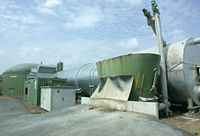
Photo from wikipedia
Abstract The increasing demand for farm animal products leads to higher pressure on the effective treatment of animal waste. Based on practice from other countries, biogas systems offer several significant… Click to show full abstract
Abstract The increasing demand for farm animal products leads to higher pressure on the effective treatment of animal waste. Based on practice from other countries, biogas systems offer several significant advantages in terms of energy, environmental and economic development. Therefore, this paper investigates the potential development of small-scale biogas systems and their suitability in rural parts of northern Sumatra. A baseline field survey using semi-structured personal interviews based on questionnaires was carried out among randomly selected rural households (n = 196) in northern Sumatra in July-August 2014. The follow-up field visits to verify the results from the first stage were organised in August–September 2016. The findings show that only small individual farmers, who own 2–5 cattle heads spread on pastures, face difficulties to collect the dung. Other farmers report enough cattle manure to cover feedstock for biogas production. The calculations show sufficient animal waste feedstock supply and consequently estimated potential of energy from biogas (845 TJy−1) in the region. Nevertheless, the respondents manage animal manure only with composting (65% of respondents) and with sun-drying for fuel purposes (6%); often they leave manure fallow. The surveyed households use mostly a combination of subsidized LPG and electricity as a primary energy source for food and feed preparation, supplemented by fuelwood as the secondary source. Only half of the respondents have some knowledge about biogas technology and its benefits. The potential for small biogas systems development in the region is supported with a sufficient amount of animal manure as feedstock and suitable designs of biogas digesters on one hand; and on the other hand, impeded by challenges related to low information accessibility and investment power of rural households.
Journal Title: Environmental development
Year Published: 2020
Link to full text (if available)
Share on Social Media: Sign Up to like & get
recommendations!